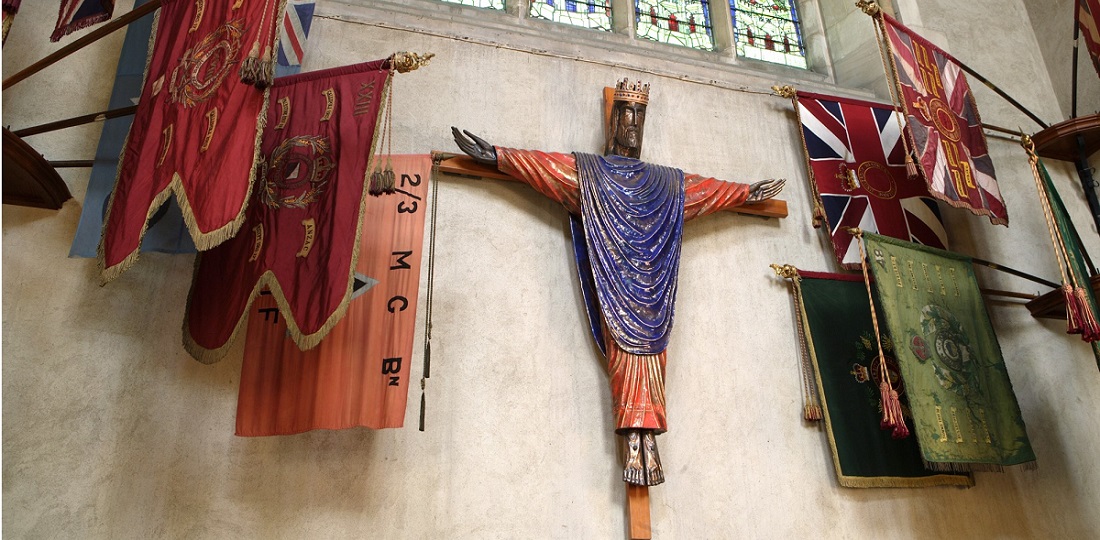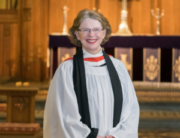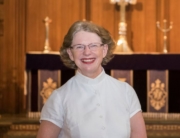Love Bade Me Welcome – a Lenten sermon series by The Rev’d Canon Jenny Wilson

Lent 4: Love Bade Me Welcome
A Spirituality of a Cathedral
The Flags
31 March 2019
The Cathedral bells rang a half muffled quarter peal to help us remember those who died in the attack at a mosque in Christchurch just a few weeks ago; a solitary bell rang the “nine tailors”, three times three rings together with rings for the number of the age of the one who died, ninety nine rings in all, to honour Bishop Bruce Rosier at his funeral on Ash Wednesday; the bells ring before each Sunday morning Choral Eucharist and after many weddings. The bells tell the city of Adelaide that something has happened, something is happening, something worthy of their attention, inviting the people of the city to worship, to mourn, to celebrate, to enter our Cathedral doors. As the spires reaching to the sky point not only to God who we know in Christ and worship here in word and sacrament, music and in the company of strangers and friends, the spires remind the city that this cathedral is here inviting them in. This cathedral, known across the cricket loving world, by the “Cathedral end” of the Adelaide Oval, belongs not just to the beloved in the faith, but to the city, to the world.
This evening, in the final of our sermon series exploring the spirituality of St Peter’s Cathedral in its 150th year, we symbolise our connection with the world by pondering the place of the Flags. On the 10 September 2011,the Governor-General, as Commander-in-Chief, presented the Queen’s and Regimental Colours to 7th Battalion, the Royal Australian Regiment (7RAR) at Torrens Parade Ground, Adelaide.Within days of this event, our cathedral was filled with soldiers, members of the 7RAR, who had come to lay up their old colours. Their old flag was to find its resting place in this cathedral under a window which portrays Christ on his cross. Bill Goodes, whose Spirituality tour of the cathedral has so guided me in the writing of this series, deserves to be quoted in full about this window: This is ‘variously known as the “Pope window” after its gifting by William Pope, a foundation Cathedral Warden, in honour of the three bishops with whom he worked, the “Crucifixion window”, or even the “Love of God window”. The figure of the suffering Christ is at the centre of the window as it is at the centre of so much of Christianity – and this centrality is pictured in the figures by which the crucifix is surrounded. At the feet of Jesus is the scroll stating “God so loved the world” while alongside him are the figures of the Old Testament prophets whose writings foreshadowed the cross.’ It is worth our mentioning at this point that William Pope is just one of the many, many benefactors without whom this Cathedral would not be standing let alone adorned with so much beauty, beauty pointing in so many ways to the story of God who we know in Christ.
A cathedral is a place for military services and also for services for the state. State funerals take place here, their organisation done with detail and precision that only the military could surpass. Funerals for friends and strangers, those close to our community will often have their ashes interred in the beautiful memorial garden planted lovingly in the shadow of the cross mirroring the Cross of Sacrifice across King William Road. Memorial services take place here. Early on in his time as Dean, Frank organised a powerful memorial service for Nelson Mandela who died on December 5th 2013. We gathered in leaders from not only different denominations from the Christian church but also leaders from other world faiths, all working together to honour the man whose words “As I walked out the door toward the gate that would lead to my freedom I knew if I didn’t leave my bitterness and hatred behind, I’d still be in prison” inspire many as they reflect on the struggle that is forgiveness.
A couple of years ago on United Nations Peace Day, Lynn Arnold gathered leaders of many world faiths who prayed together on our nave platform at a service when Rob Croser’s Independent Theatre Company inspired us with readings about war and peace. Our cathedral hosts many art forms – drama, the fine arts and, of course, music. In this way we welcome in many who may not be of our faith but who find their lives nurtured and inspired by drama, art and music. Many in our city who may not necessarily assent to the Christian faith, experience Good Friday as a day on which they feel called to spend time in reflection. We honour this truth, on Good Friday at 3 o’clock in the afternoon each year, when the Cathedral musicians put on a concert of music for reflection, in which Allegri’s Miserere is often sung.
Funerals are held here for those we know well and for strangers. A baby who I will call Amelia, though that is not her name, and her twin sister were born prematurely at 26 weeks. After eighteen months’ struggle for life in the Women’s and Children’s Hospital, Amelia died. Her parents rang our office for help with her funeral. We had not known the family at all. We know them now. Amelia’s funeral took place in this cathedral and we attended her burial at a cemetery close to the family’s home. Each year on the anniversary of her death, the family come to pray, to talk, to remember, to grieve a little more, to hold onto faith. Funerals for friends and strangers take place here.
So do weddings. Often one of us will meet with a couple to discuss their wedding and we gently inquire what brought them here, often to a place whose doors they have not yet entered. “I’ve driven past this building so often and, since I was a little girl, I wanted to be married here,” I have heard a bride say on more than one occasion. We do need one member of the couple to be baptised for an Anglican wedding to take place but often their connection with our faith is just a whisper. The building has called them and only God will know how they will be nurtured in that faith by their conversations with cathedral clergy and staff and their sharing their wedding ceremony with us. On occasion couples return with their children asking us to welcome them in baptism.
Near the flags is situated a place for the lighting of candles, one of two places permanently set up for this in the Cathedral. On the way to the Lady Chapel the pricket stand where candles can be placed sits beneath an icon of …. A kneeler is placed there for private prayers for those close to the heart of the one who prays, often for those who are suffering or dying.
What are we doing when we light candles and pray for those we love dearly or those who have been injured far away? Michael Mayne, former Dean of Westminster Abbey, wrote in Pray, Love, Remember, the book from which the idea for this sermon series came, “None of us is immune to pain. We get sick; we die. We lose those who mean the most to us in the world. There is no such thing as divine protection. Jesus died an agonizing death. So what did he prove? He died to prove the seemingly foolish claim that the self-giving love that shaped his own life is what lies at the heart of the universe; and that if you would name the unimaginable presence that informs it and holds it in being, then you must use the name ‘Abba’, the intimate name a child gives its father. And that life is learning to trust that these things are so; and learning to grow in that self-giving love.”[1]
When we light candles we place into this love the people, the situations, the struggles for which we pray.
Each week at Choral evensong on a Wednesday we light candles for peace whilst the anthem is being sung by the choir. Not long ago a man walked into a Manchester concert venue and, blowing himself up, killed scores of innocent human beings and injured many more. A man walked into our Cathedral during that candle lighting service the following Wednesday. The service was well under way and the man joined us. But when the service ended and the organ was being played, the man who had walked into our Cathedral came forward and lit a candle, and placed his candle in the bowl with the many other lighted candles, and he took a photo of the bowl and the prayer for the Manchester victims we placed by the candles. He came over to me at the side door of our Cathedral and he shook my hand and he said this. “I am the director of the Cathedral in Manchester. I will send this photo to my Dean. Please tell your Dean. Thank you for doing this.”
In so many ways this place welcomes in the world.
What are we doing here in St Peter’s Cathedral? This place where love bids us welcome? Michael Mayne asks this question of his Abbey:
“What is this space for? It is where human beings, in all our marvellous diversity, may sometimes engage with the transcendent; for the space we have inherited is not just any old space, but a holy space, the place where past generations have met in search of that encounter between the seen and the unseen.”[2]
Our witness here in this Cathedral, is that this “unseen” is God. God who shines forth in Jesus Christ, God whose story is told here in word and sacrament, music, drama and art, wood and glass and stone, God who we know in the presence of the body of Christ gathered here, God who through this cathedral makes us welcome.
Love bade me welcome: yet my soul drew back,
Guilty of dust and sin.
But quick-eyed Love, observing me grow slack
From my first entrance in,
Drew nearer to me, sweetly questioning
If I lacked anything.
“A guest,” I answered, “worthy to be here”:
Love said, “You shall be he.”
“I, the unkind, ungrateful? Ah, my dear,
I cannot look on thee.”
Love took my hand, and smiling did reply,
“Who made the eyes but I?”
“Truth, Lord; but I have marred them; let my shame
Go where it doth deserve.”
“And know you not,” says Love, “who bore the blame?”
“My dear, then I will serve.”
“You must sit down,” says Love, “and taste my meat.”
So I
did sit and eat. (George Herbert)
[1] Michael Mayne Love, Pray, Remember p12.
[2] Michael Mayne p 107.




